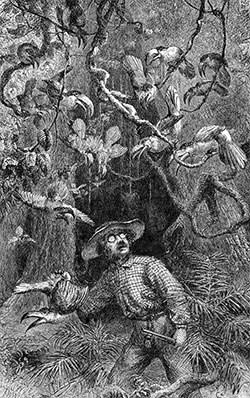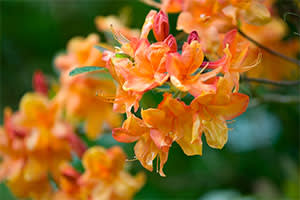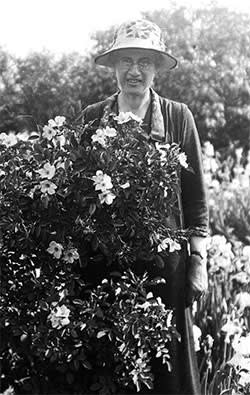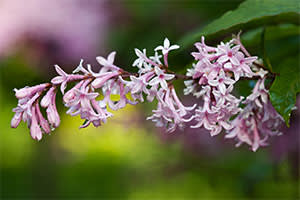
Press » How the world's great gardeners grew their own expertise

There are many renowned naturalists and plant breeders who succeeded without any formal training
May 8, 2015
Nobody in the UK’s general election campaign has raised the scope for “teach yourself”. We have business schools teaching people to do what they used to learn better on the job. We have degree courses in sports management and even in social horticultural therapy. We used to have a whole series of “Teach Yourself” books, of which Teach Yourself Turkish is still a classic. I believe in it. “Teach yourself” is much cheaper than a loan to go to a university, which has minimal interest anyway in personal teaching. It has been the making of many great gardeners. They reject the view that unless we learn in a college, we will be sunk in a sea of east Asian competition. “Teach yourself” is also exemplified by some of our greatest naturalists, shrewd and patient in the field and without any diplomas before setting out.
A former neurologist and a former director of the Royal Geographic Society have recently amplified our sense of what is possible. Judith Taylor lives and writes in California. Her Visions of Loveliness (2014) advances the under-researched and ill-co-ordinated history of plant breeding and selection, on which our gardens and nurseries depend. John Hemming’s Naturalists in Paradise (2015) takes the story out into the wild with three astonishing English heroes. None of them was formally trained at school nor born anywhere near a silver spoon. Hemming is himself an explorer with years of experience in South America and a worldwide reputation for his histories of the Spanish conquests and the local resistance to them. His three naturalists, Alfred Russel Wallace, Henry Bates and Richard Spruce, are an ideal subject for his expertise. I finished reading his clear and compelling book in awe at their courage, skill and achievements. Each of them was self-taught, an example of what can be done by reading, travelling and applied common sense.
After reading Taylor, I will embark with new eyes on the glorious weeks which are now beginning, the season of lilacs and rhododendrons, lupins, delphiniums, roses and sweet peas. Many of the best have been bred for us, but their breeders were never saddled with a loathsome student loan. They learned by observation and were impelled by what Taylor calls a “vision of loveliness”. I am off tomorrow to enjoy rhododendrons and azaleas at their best. As I admire them, I will think of Pierre Mortier, a baker in Ghent. Without any formal training he used the warmth of his baking ovens to speed up the flowering of late azaleas so that he could cross their flowers with early-flowering varieties. Ghent azaleas were the results of “teach yourself” and parallel thinking. Nowadays, they are mainstays of great collections all over the world.
May 8, 2015
Nobody in the UK’s general election campaign has raised the scope for “teach yourself”. We have business schools teaching people to do what they used to learn better on the job. We have degree courses in sports management and even in social horticultural therapy. We used to have a whole series of “Teach Yourself” books, of which Teach Yourself Turkish is still a classic. I believe in it. “Teach yourself” is much cheaper than a loan to go to a university, which has minimal interest anyway in personal teaching. It has been the making of many great gardeners. They reject the view that unless we learn in a college, we will be sunk in a sea of east Asian competition. “Teach yourself” is also exemplified by some of our greatest naturalists, shrewd and patient in the field and without any diplomas before setting out.
A former neurologist and a former director of the Royal Geographic Society have recently amplified our sense of what is possible. Judith Taylor lives and writes in California. Her Visions of Loveliness (2014) advances the under-researched and ill-co-ordinated history of plant breeding and selection, on which our gardens and nurseries depend. John Hemming’s Naturalists in Paradise (2015) takes the story out into the wild with three astonishing English heroes. None of them was formally trained at school nor born anywhere near a silver spoon. Hemming is himself an explorer with years of experience in South America and a worldwide reputation for his histories of the Spanish conquests and the local resistance to them. His three naturalists, Alfred Russel Wallace, Henry Bates and Richard Spruce, are an ideal subject for his expertise. I finished reading his clear and compelling book in awe at their courage, skill and achievements. Each of them was self-taught, an example of what can be done by reading, travelling and applied common sense.
After reading Taylor, I will embark with new eyes on the glorious weeks which are now beginning, the season of lilacs and rhododendrons, lupins, delphiniums, roses and sweet peas. Many of the best have been bred for us, but their breeders were never saddled with a loathsome student loan. They learned by observation and were impelled by what Taylor calls a “vision of loveliness”. I am off tomorrow to enjoy rhododendrons and azaleas at their best. As I admire them, I will think of Pierre Mortier, a baker in Ghent. Without any formal training he used the warmth of his baking ovens to speed up the flowering of late azaleas so that he could cross their flowers with early-flowering varieties. Ghent azaleas were the results of “teach yourself” and parallel thinking. Nowadays, they are mainstays of great collections all over the world.

An 1863 engraving of Henry Bates being attacked by toucans in the Amazon
Soon it will be the weeks of lilacs and then of lupins. Like me, Taylor has been fascinated by the history of Isabella Preston, who created many good hybrid lilacs which are still in gardens. Syringa Bellicent is the best-known and Desdemona is just as good. Preston’s story is indeed fascinating. She was born in Lancashire in 1881 and learned most from her father as he gardened round her. Following her sister, she emigrated to Ontario, Canada, in 1912. She tried a course at the Ontario Agricultural College, but gave up as she wanted to work with a breeder and become one herself. She read widely and enrolled as a “day labourer” at Ottawa’s Central Experimental Farm. She rose rapidly to become a specialist in ornamental horticulture, even though she had no degree or diploma. She then bred 120 new varieties of lilac and even more new varieties of lily. When she retired in the 1950s, she laid out her garden as the Central Farm in miniature, “but free from bureaucratic interference”. Essentially, she had taught herself.

Ghent azalea
So had the king of lupins, George Russell. In 1911, as a working gardener aged 54, he saw a vase of lupins on the kitchen table of his Yorkshire employer, Mrs Micklethwaite, and decided there and then that the flowers could be improved and that he would do it. He had a keen gardening father who took him to village flower shows and also, Taylor remarks, “took two newspapers a day”. His son worked in nurseries only, with minimal schooling but his name is still applied to the best lupins, some of which indeed descend from his original crosses. He was a plain Yorkshireman who had a moment of decision and then taught himself what to do.

Isabella Preston
Ottawa, c1927
Preston, Russell and many others changed the range of gardening, but they are as nothing to one of Hemming’s heroes, Richard Spruce. He was another Yorkshireman, born on the edge of the Castle Howard estate near York. His father was a schoolmaster and taught his son instead of sending him to school. When he remarried, he fathered eight daughters and left Richard to fend for himself. On the Yorkshire moors, the boy discovered his passion for plants and mosses. He found new ones and wrote a series of important papers on liverworts, or hepaticas. Kew took notice and, aged 32, he was sent off to the Amazon to study its uncharted botany. He was a self-taught genius.
Hemming tells a hardly believable story with great clarity and sympathy. Spruce’s collections in the Amazon valley and the north Andes are still unsurpassed. He identified hundreds of unknown species, gained the trust of the local Indians and even experimented with their powerfully hallucinogenic plants. Above all, it was Spruce who first acquired seeds from forms of the cinchona tree, from whose bark quinine can be distilled. It was a medical breakthrough and one that many had sought. Only the untrained Spruce’s courage, manners and skill managed to acquire the closely guarded bark from Ecuador.
Hemming tells a hardly believable story with great clarity and sympathy. Spruce’s collections in the Amazon valley and the north Andes are still unsurpassed. He identified hundreds of unknown species, gained the trust of the local Indians and even experimented with their powerfully hallucinogenic plants. Above all, it was Spruce who first acquired seeds from forms of the cinchona tree, from whose bark quinine can be distilled. It was a medical breakthrough and one that many had sought. Only the untrained Spruce’s courage, manners and skill managed to acquire the closely guarded bark from Ecuador.

Syringa x josiflexa Bellicent
Spruce lived to be 76, dying in simple circumstances in his beloved Yorkshire. His achievements — and their later influence — are lucidly told by Hemming. In the 1950s and 1960s, Richard Schultes, for example, was professor of botany at no less an institution than Harvard. He is most famous for discovering the “magic mushroom”, or hallucinogenic peyote. From the 1950s, he extolled Spruce’s work, the deliberate role model, he insisted, for his own. Self-taught Yorkshireman influences Harvard academic. The moral is inspiring: it is never too late or too daunting to teach yourself.
‘Naturalists In Paradise’, by John Hemming, Thames & Hudson, £19.95
‘Visions of Loveliness’, by Judith M Taylor, Swallow/Ohio University Press, $23.96
Photographs: The Naturalist on the River Amazons; Lee Avison/Gap Photos; Isabella Preston Collection; Christina Bollen/Gap Photos
‘Naturalists In Paradise’, by John Hemming, Thames & Hudson, £19.95
‘Visions of Loveliness’, by Judith M Taylor, Swallow/Ohio University Press, $23.96
Photographs: The Naturalist on the River Amazons; Lee Avison/Gap Photos; Isabella Preston Collection; Christina Bollen/Gap Photos
The Financial Times, May 8, 2015

